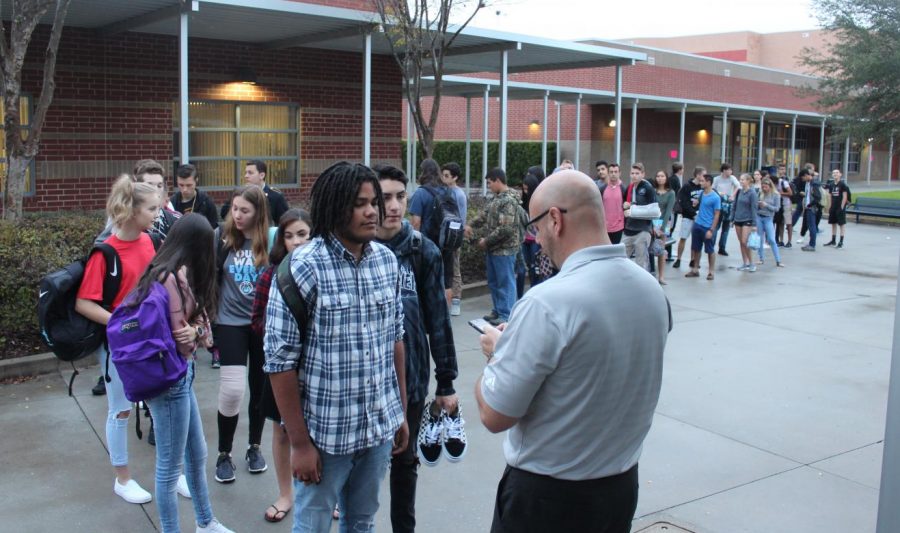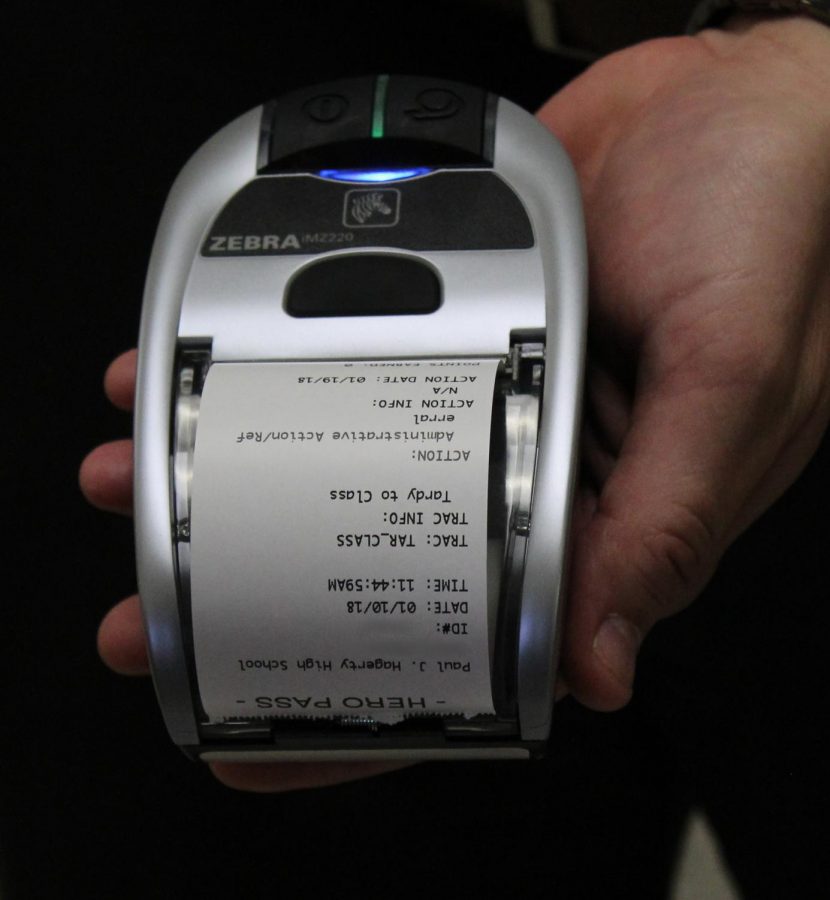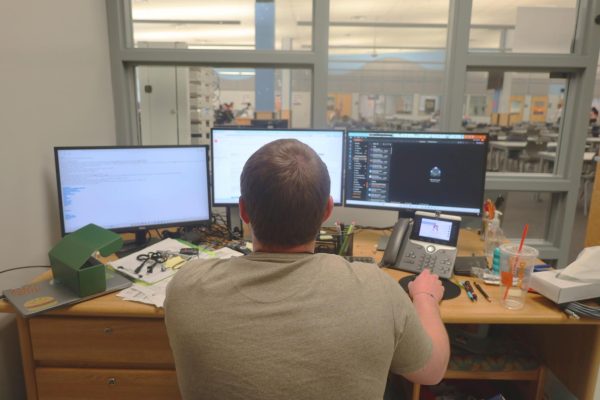Hero K12 system remodels tardy policy
photo by Leah Harper
Assistant principal Doug Miller hands out tardy slips for first period on Tuesday, Jan. 9. The line had 153 students who needed a pass and most students spent 10 to 20 minutes getting a pass.
On Tuesday, Jan. 9, at 7:20 a.m. the front doors to the school were locked and a line stretched from the cafeteria to the front office. In this line, 153 students were introduced for the first time to the new Hero K12 system and waited for their tardy slip pass that let them enter first period.
The Hero K12 program allows staff, students and parents to track student behaviors, notably tardies. The program uses a device to scan the student’s ID, then an administrator prints out a tardy slip with information such as the student’s name, ID number, the total number of tardy entries and the consequences. The scanners can also track other behaviors such as dress code and uploads this information into a database.
The idea of the program originated because of the high number of tardies and students walking around campus during class hours. In the hope of improving the students’ punctuality, assistant principal Doug Miller suggested the use of Hero K12.
“The significant tardy issues at the school were noted and we have seen schools with similar issues be successful while using the Hero k12 system,” Miller said.
Hero K12 not only tracks each tardy but also provides students with specific consequences for each. The consequences are as follows: the first tardy results in a warning, the second and third tardy each result in an hour detention, the fourth leads to Saturday school and the fifth or more tardies earn referrals.
Unlike the old tardy policy, tardies from multiple periods will be counted together: if a student is tardy to three different class periods, it will be counted as three tardies and a detention will be given. However, first and second periods are considered as ‘Tardy to School,’ while for the rest of the periods are considered ‘Tardy to Class.’ These two will have different tardy tracks, but both will follow the same list of consequences. All tardy entries will be erased every nine weeks.
From Jan. 8-12, the program will be used but only as practice; however, starting Tuesday, Jan. 16, Hero will be fully applied with consequences.
The new rule also requires all students to have their IDs at all times, since these must be scanned for pass printing stations to give the student a slip. Those without IDs are advised to visit the media center early in the morning and get a new ID. If a student has an ID but forgets it, their name will be looked up in the system and an entry for forgetting the ID will be given as well. However, there is no policy for missing IDs or dress code information yet.
Although the school’s use of Hero K12 will initially be to track tardies, the system will later be used to track entries of other negative behaviors such as dress code, parking lot violations and the number of times student do not have their IDs with them.
“We are starting with the negative uses, but later on, all teachers will be using it to track good student behaviors, giving students points or Husky bucks for individual things,” Miller said.
Due to teacher training, administration plans to start positive entries either during fourth quarter or beginning of next year.
All of the entries will be stored for students and parents to access through the Hero app, available for iPhones and Androids. Students and parents can create an account that will show detailed records of tardies, detentions, Saturday schools and positive and negative points.
Throughout the trial week, administrators have encountered challenges. Due to the number of students who have been late and the small number of scanners and staff trained to use the Hero K12 system, the distribution of passes has been slow. Some students have had to wait 10 to 20 minutes to get a late pass for class.
To fix this, Miller has taught more staff about the program as the trial week has advanced, and more places, such as lower and upper administration, attendance, the front office and the media center are now able to give tardy passes. More administrators have also been made available to print out slips at the courtyard.
“One of our goals is to try to minimize the minutes that [it] takes students who need a pass to get to class, and we can do this by getting more people trained,” Miller said.
For now, students who take 10 or more minutes to get to class due to waiting in line to get a pass will not be counted as absent, but this will change as administrators find a way for teachers to know how many minutes it took for the student to get a tardy slip.
Overall, teachers and administrators expect positive things from the Hero K12 system. Miller hopes the program will teach student essential employment skills like responsibility and punctuality and build a stronger line of communication between parents and the school throughout the app.
An email regarding the use of the Hero K12 and the new tardy policy was sent out to parents and students on Wednesday, Jan. 10, and more detailed information regarding the policy can be found in this video.
For information on how to get started with the app ‘Hero’ can be found in the Hero Parent Guide
More information regarding a detailed explanation on Hero tardy passes can be found in this video
HOW THE HERO K12 SYSTEM WORKS
Your donation will support the student journalists of Hagerty High School. We are an ad-free publication, and your contribution helps us publish six issues of the BluePrint and cover our annual website hosting costs. Thank you so much!












Vicky Martin Gonzalez | Jan 16, 2018 at 11:54 am
I find the idea of behavior tracking highly disturbing. Who has access to that data? I can guarantee the system can be hacked. Furthermore, tracking tardies using this system seems like it would shorten instructional time. There are many reasons for being tardy, some are legitimate. What if my student has car trouble more than once in a 9 week period? I would really be upset if he had to serve detention for that, especially if I have to drive him.